 Loss of teeth is a common problem. Unfortunately, people of both age and age are facing it.
Loss of teeth is a common problem. Unfortunately, people of both age and age are facing it.
In the absence of a significant number of teeth, the most optimal solution is prosthetics. And which one - in each specific case is considered individually.
Contents
- What should I do if my teeth are missing partially?
- Crowns - the most popular method
- Bridging prosthesis
- Plate partial removable prosthesis
- Implantation - efficient but expensive
- Methods used in the complete absence of teeth
- Plastic prosthesis
- On implants
What if there are no teeth partially?
In order to understand which prosthesis should be used in this or that case, it is necessary to study well the positive and negative aspects of possible variants, to learn the features of each of them and the indications for use.
With partial absence of teeth, the following methods of dental prosthetics are suitable.
Crowns - the most popular method of
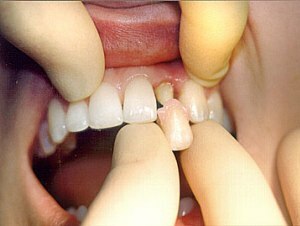 Dental crowns in dentistry have been used for a long time and successfully. They resort to them in those cases when the tooth( or several) is destroyed very much. Most often this occurs when more than 70% of the crown part of the tooth is missing and there is no question of installing the filling.
Dental crowns in dentistry have been used for a long time and successfully. They resort to them in those cases when the tooth( or several) is destroyed very much. Most often this occurs when more than 70% of the crown part of the tooth is missing and there is no question of installing the filling.
In addition, crowns are installed and for aesthetic purposes, in order to hide the obvious defect.
The crown is something like a cap, worn on a destroyed chewing element. This allows:
-
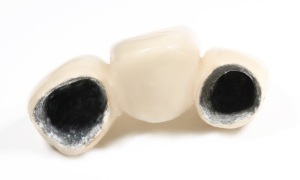
Metal-ceramic crowns
to restore the dentition;
- return the tooth to its former, natural form, and often also the color;
- protect it from further destruction and development of caries;
- give him the opportunity to fully perform his function.
Until recently, gold crowns were widely used. But at present, this metal in prosthetics is almost not used because of its low strength.
The most popular are metal, metal-ceramic and all-ceramic crowns.
Bridging prosthesis
This type of prosthesis is a design of two crowns and several artificial teeth between them. 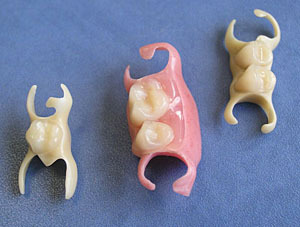 External view, it resembles a bridge, in connection with which it received its name.
External view, it resembles a bridge, in connection with which it received its name.
Bridges are recommended in the absence of 1 to 4 teeth in a row. Depending on the complexity of the case and the functional purpose of the missing chewing elements, the patient is provided with a removable or non-removable prosthesis, integral or integral.
The material of execution is also selected individually, but this issue is rather of a financial nature.
Plastic partial removable prosthesis
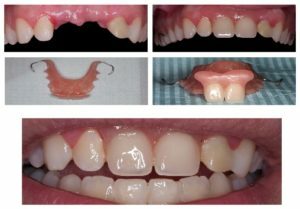
In the photo removable prosthesis with partial absence of teeth
This prosthesis is recommended for patients, in the absence of a large number of teeth. That is, those who still have healthy teeth on the jaw, but a significant part of the chewing organs is absent. The base part of the structure is a plastic base, on which are placed artificial teeth and fastening elements.
In the manufacture of hard, but most affordable plastic or soft, but more expensive.
Hard prostheses are less comfortable to wear than their soft counterparts. When using such a prosthesis, the patient's taste is broken.
Clasp prosthesis is also used for partial tooth loss, representing a metal arc with artificial teeth. It is an optimal solution for partial dentures.
Implantation - effective but expensive
Implantation involves replacing lost teeth with analogs made from artificial materials. At the moment, this type of prosthetics is rightly recognized as the most effective. The dental implant consists of three parts:
- body implant implanted in the jaw;
- abutment connecting the implant body and the artificial crown;
- crown implant.

Fixed prosthetics on implants in the absence of anterior teeth
Implantation is used in the case of a single defect in the dentition and in the absence of 2 to 4 consecutive teeth.
Methods used in the complete absence of teeth
Prosthetic tooth without teeth - so often called treatment for the restoration of the dentition after the loss of all chewing elements.
With the complete absence of teeth, the patient recommends the use of plate prostheses or implant prosthetics.
Plastic prosthesis
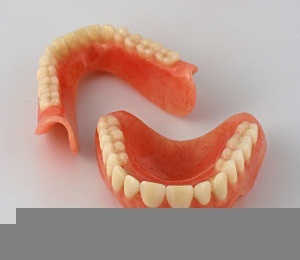 Full prosthesis is recommended in cases where all teeth are missing, both in the upper and lower rows, but it is not possible to install implants or other prostheses.
Full prosthesis is recommended in cases where all teeth are missing, both in the upper and lower rows, but it is not possible to install implants or other prostheses.
The construction consists of a base( base) and artificial chewing elements. Hard or soft plastic is used for manufacturing. Mounting is carried out due to the suction effect and is not very reliable.
On implants
It is believed that dental prosthesis using implants is the most desired and effective in the complete absence of teeth. Titanium rods, implanted in the jaw, serve as a reliable support for the denture and ensure its reliable attachment. At the same time,
- prostheses are used on beam implants , which are very similar in appearance to lamellar implants;
- prostheses on button implants , having in their structure a special fixing element, reminiscent of buttons for clothing.
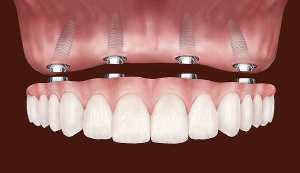 The absence of one or more teeth is quite a serious problem, which can lead to significant negative consequences for both the remaining chewing elements and human health in general.
The absence of one or more teeth is quite a serious problem, which can lead to significant negative consequences for both the remaining chewing elements and human health in general.
Prosthesis of the upper and lower jaws in the complete absence of teeth with the support of implants:
Therefore, leaving it without attention and appropriate treatment can not be done. Dental prosthetics at the present stage of development of dentistry allows to restore the patient's dentitions in the most effective and qualitative way even in the most difficult cases.
